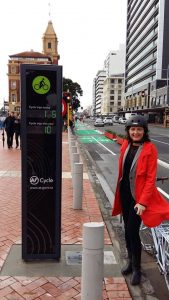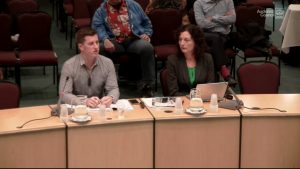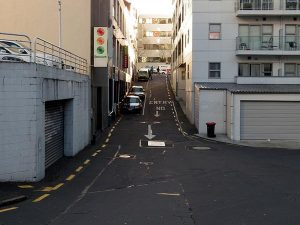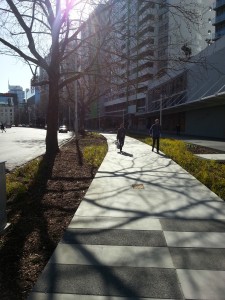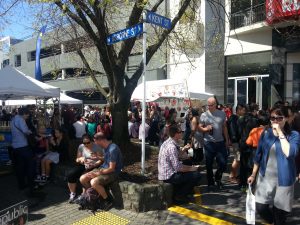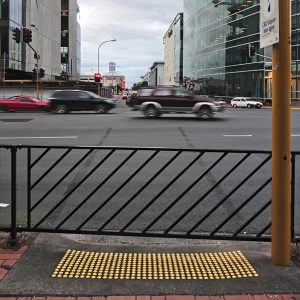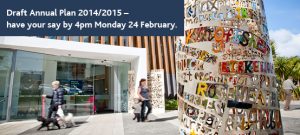Report (on the September business meeting agenda) covering the period 7 August until 10 September 2017.
Highlights
Local Board plan hearing
Consultation on the draft Waitematā Local Board Plan 2017 concluded with a hearing held on 8 August. 15 submitters presented to the board on a range of topics.
At the hearing meeting we also received all the submissions and a high level overview of all the data gathered through the public consultation process. In total 158 submissions were received on the draft Plan 2017. In addition, 34 people provided feedback at the ‘Have your Say’ engagement events and there were 11 pieces of feedback gathered through Facebook.
80 per cent of respondents either agreed or strongly agreed with this question “are we on the right track with our proposed local board plan?”, while 16 per cent neither agreed or disagreed and 4 per cent either disagreed or strongly disagreed.
We are in the process of revising the draft based on the feedback and will sign off the final plan at the Board’s October business meeting.
Draft Meola Reef Te Tokaroa Development Plan consultation
 In August the Board signed off the draft Meola Reef Te Tokaroa Development Plan plan for consultation. Consultation on the draft is now open until 29 September. The following introduction to the plan is provided on the Shape Auckland website.
In August the Board signed off the draft Meola Reef Te Tokaroa Development Plan plan for consultation. Consultation on the draft is now open until 29 September. The following introduction to the plan is provided on the Shape Auckland website.
- The purpose of the development plan is to coordinate development of Meola Reef Reserve Te Tokaroa, in the short, medium and long term (10+ years).
- Such a long-term plan provides guidance for any changes to the area:
- maintain and enhance the reserve’s ecological outcomes
- respond to needs, concerns and desires of Mana Whenua, key stakeholders and the community; and
- plan for future demand and needs.
- Meola Reef is a lava reef formation that reaches over two kilometres into the Waitematā harbour. A landfill was developed on the reef from 1930 to 1976. After closure of the landfill and capping, the reserve informally developed as a dog walking destination. The Reserve is now known as one of Auckland’s primary off and on-leash dog parks.
- Management and mitigation of the closed landfill which underlies the reserve, is outside of the scope of the development plan. However, any development of the park requires any landfill management works to be completed before park development works.
- The development plan actions are unfunded at this stage. The development plan will inform funding decisions.
Link to the draft plan and feedback form here
I worked with board member Rob Thomas to finalise the Board’s feedback on Auckland Regional Pest Management Plan Review (Attached to the agenda).
I attended the launch of Predator Free Grey Lynn at the Grey Lynn Farmers Market with Grey Lynn local, Jesse Mulligan (photo right) with support from Predator Free New Zealand Trust and Kiwibank. We also heard from Kelmarna Gardens for plans for Predator Free Ponsonby.
The importance of pest eradication in the survival of seabirds was highlighted at the excellent Hauraki Gulf Seminar Taking Flight I attended on 6 September at Auckland Museum.
Coxs Bay playground
 The opening of the new Coxs Bay playground went ahead on 9 September despite forecast downpours. The playground is based on a theme of natural play and the fact that the area used to be a seasonal iwi harvesting place. New planting and natural play features such as boulders and climbing rocks were included in the design. A playground celebration will be held on 12 October.
The opening of the new Coxs Bay playground went ahead on 9 September despite forecast downpours. The playground is based on a theme of natural play and the fact that the area used to be a seasonal iwi harvesting place. New planting and natural play features such as boulders and climbing rocks were included in the design. A playground celebration will be held on 12 October.
The renewal budget for the project was $370,000.
Western Springs Outer Fields bush tracks
 I have been following up on the poor condition of the Western Springs Outer Fields bush tracks. Maintenance of the area had fallen between Regional Facilities Auckland (RFA) and Council’s Community Facilities with no maintenance undertaken for some time.
I have been following up on the poor condition of the Western Springs Outer Fields bush tracks. Maintenance of the area had fallen between Regional Facilities Auckland (RFA) and Council’s Community Facilities with no maintenance undertaken for some time.
RFA recently reported securing sufficient budget (quoted by City Parks as $28,752) to undertake the remedial works, as scoped by City Parks. RFA now needs to complete the requisite procurement process and is seeking to complete the required physical work once we have improved weather conditions so the track will be fully functional for the upcoming summer.
Waima Street Pedestrian bridge
For some time I have also been following up about the condition of the Waima Street pedestrian bridge that provides a walking and cycling connection between Arch Hill and the NW cycleway. At a meeting with the NZTA’s Director Regional Relationships for the Upper North Island, Pete Clarke we heard that NZTA has now secured a budget to undertake maintenance on the bridge (photo right – Albert Eden Local Board side of the bridge).
Walking and cycling improvements
In my September Ponsonby News update I provided an overview of the major package of walking and cycling improvements that are either underway or about to start. I’ve been attending the regular meetings organised by West Lynn business owners concerned about the loss of parking, location of bus stops and the construction disruption.
Tamaki Drive cycleway route
 In June Auckland Transport consulted on the Tamaki Drive Cycleway proposal from Quay Street to Ngapipi Road. Auckland Transport’s options for the route where overwhelmingly rejected through the public feedback. A revised design is now under investigation. As transport portfolio lead I provided the following initial feedback on behalf of the Board:
In June Auckland Transport consulted on the Tamaki Drive Cycleway proposal from Quay Street to Ngapipi Road. Auckland Transport’s options for the route where overwhelmingly rejected through the public feedback. A revised design is now under investigation. As transport portfolio lead I provided the following initial feedback on behalf of the Board:
The Waitematā Local Board is pleased that Auckland Transport has listened to the feedback received through the public consultation and is investigating a bi-directional cycle route on Tamaki Drive to the Ngapipi intersection. The Board supports this option with general traffic lanes that are as wide as possible to increase the safety of road riders.
The Board does not support the section between Solent Street and the Strand remaining as a shared path for the following reasons:
- The investment over the entire route is degraded by maintaining a lower level of service for this section.
- It is not fit for purpose for the future numbers estimated to use this route once it is fully connected to the network
- A shared path with high levels of users is not safe especially for people walking, running, skating etc alongside a traffic lane with high vehicles volumes
- The proposed width of the shared path is not best practice
The Board seeks a continuous connection from Quay St along Tamaki Drive with a consistent level of service. The Board therefore requests that AT work with NZTA to investigate the continuation of the bi-directional cycle route through the Solent St to the Strand section by re-allocating road space
The Board also requests that
- The bi-directional cycle route continues through the Solent Street intersection and that this intersection is re-designed to prioritise the safety of pedestrians and people on bikes
- A safe, separated connection is provided to the Gladstone Road cycle route through the Strand intersection
- Auckland Transport investigate opportunities for sustainable urban drainage/water sensitive design and opportunities to plant new street trees along the route
Auckland Transport will undertake further public consultation on the revised design.
Ponsonby Road pedestrian improvements project
This project has caused a lot of headaches with delays and construction issues. The project is now back on track on due to be completed by mid-November. The latest update from Auckland Transport (as at 8 September)
- Both the Anglesea and Brown Street intersection works are progressing as planned. The drainage work on Anglesea Street is now complete and work has begun on the kerb build-outs.
- The remaining work at Pollen Street intersection is expected to be complete before mid-November 2017.
Meetings and workshops: 7 August until 10 September
- Weekly Chair’s meeting every Monday morning
- Meeting with NZTA representatives on 7 August to discuss transport issues in Waitematā
- Waitematā Local Board workshops on 8, 22, 29 August and 5 September
- Waitematā Local Board Plan hearing on 8 August
- Planning Committee waterfront briefing on 9 August
- Meeting to discuss Auckland Transport’s temporary installations on K’rd for the introduction of double decker buses
- Meetings with West Lynn business owners on 9, 16 August and 8 September to discuss cycleway construction works planned by Auckland Transport
- Meeting on 10 August to discuss Ellen Melville Centre opening and planned Community Open Day
- Meeting with Council planners to discuss the development of a Parnell precinct plan
- Chair’s draft recommendations run through on 12 August
- Interview panel member on 12 August for the CEO position at Auckland Transport
- Monthly Local Board Chairs’ Forum on 15 August
- Catch up with the Waitematā Youth Collective representatives on 16 August
- Waitematā Local Board business meeting on 16 August
- Monthly comms meeting on 16 August
- Transport portfolio catch up on 17 August
- Meeting with Council officers and the Principal of Auckland Girls’ Grammar School on 17 August to discuss possible options for developing in partnership the swimming pool and gym at the school
- Use of social media by Council discussion with comms officers on 17 August
- Meeting on 18 August with Richmond Rovers Rugby League Club representatives and Auckland Council staff to discuss development of multipurpose facility and new clubrooms in Grey Lynn Park
- Judging for the NZTA cycle friendly awards on 18 August at the offices of the AA
- Local Boards sub-regional workshop on 21 August
- Newmarket level crossing community liaison meeting hosted by Auckland Transport at Jubilee Hall on 21 August
- Environment portfolio meeting on 24 August
- Engagement adviser catch up
- Meeting with representatives from Kelmarna Gardens
- Site Visit on 24 August to discuss tree planting project on St Marys Road with Chair, SMBA, Auckland Transport and Auckland Council arborist
- Meeting on 25 August with Auckland Transport representatives and K’rd Business Association GM to discuss poor process and communication regarding the installation of temporary safety treatments on K’rd for the double decker bus project
- Planning committee joint workshop on 29 August: waterfront and city centre planning
- Franklin Road community liaison meeting hosted by Auckland Transport on 30 August
- Domain Committee meeting on 31 August
- Waitematā Local Board member “Behind the Scenes” tour of Auckland’s War Memorial Museum on 1 September to show the diverse work currently being carried out in order to meet the needs of our growing and diverse city. The tour included the Pacific Collections Access Project (PCAP) – connecting with communities, Digital lab – collections on line and Basement storage – kaitiaki
- Meeting on 1 September with the Sustainability squad at Parnell School to discuss their plans for a waste reduction project
- Met with Sara Stace a city shaper and architect focused on cycle planning visiting from Australia
- City Centre and Waterfront Planning Refresh Local Board Input on 5 September
- Attended the Hauraki Gulf Marine Park Seminar 2017 – Taking Flight at Auckland Museum on 6 September
- Catch up with General Manager, Newmarket Business Association on 7 September
- Finance Committee 10 year budget joint workshop with governing body members and local board chairs on 7 September
- Meeting with Mayor Goff on 8 September to discuss opening of Ellen Melville Centre and Freyberg Place
- Communication and Engagement Expo on 8 September to find out what department does (covering Public Affairs – media relations, internal, corporate and local communications, Marketing & publicity, Citizen engagements and Insights, Brand & Channel – content, channels, design, Strategic Planning & Performance)
Events and functions: 7 August until 10 September
- Auckland Foundation event with guest speaker Julie Nelson of Housing First at Gus Fisher Gallery on 8 August
- LATE at the Museum on 9 August at the invitation of Auckland Museum
- Eat Albert Street (link to video of the event) on 10 August (Photo below: Free kai provided by Everybody eats at Griffith Gardens)
- Vintage Austin Register – Auckland Branch AGM on 13 August
- Splice cuppa event at Scarecrow Café on 15 August
- Opening night of Nell Gywnn at Waterfront Theatre on 17 August at the invitation of Auckland Theatre Company
 Presided at the Citizenship ceremony at Auckland Town Hall on 17 August (photo below with Kaumatua Bob Hawke, Waitemata Local Board member Richard Northey and Chair of Maungakiekie- Tamaki Local Board Josephine Bartley)
Presided at the Citizenship ceremony at Auckland Town Hall on 17 August (photo below with Kaumatua Bob Hawke, Waitemata Local Board member Richard Northey and Chair of Maungakiekie- Tamaki Local Board Josephine Bartley)- Margaret Mary’s farewell from TAPAC on 18 August
- Funeral of Graham (Rocky) McGlynn, RSC President at the Grey Lynn RSC on 19 August
- Labour’s Election Launch at the Auckland Town Hall on Sunday 20 August
- PSA’s book launch on 21 August: Progressive Thinking: Ten Perspectives on Housing with panel discussion facilitated by Simon Wilson
- Opening night of Matilda at the Civic Theatre at the invitation of ATEED on 24 August
- Modelled on the Project Glow wear runway show on 26 August
 Launch of Predator Free Grey Lynn at the Grey Lynn Farmers Market on 27 August
Launch of Predator Free Grey Lynn at the Grey Lynn Farmers Market on 27 August- Lela Jacobs and Jimmy D Fashion Week shows at the invitation of the K’rd Business Association
- Leaving function for Brett O’Reilly, ATEED CEO at GRID AKL on 31 August (Photo right with Brett)
- Random Acts of Kindness Day on 1 September organised by Splice ( I dropped by the Splice team below handing out free pots of honey on K’rd)
- Took part in a tactical urbanism event with Walk Auckland’s Andy Smith to mark the 8th Anniversary of the 40km speed limit on
 Ponsonby Road (photo right with our “speed gun” hairdryers)
Ponsonby Road (photo right with our “speed gun” hairdryers) - Opening of the Corsini Collection at the Auckland Art Gallery on 2 September
- Attended Merchant Navy Day Auckland Remembrance Service on 3 September at the Maritime Museum (Photo below with Councillors Daniel Newman and Mike Lee)
- Meet the candidates meeting for Auckland Central at St Matthews organised by the Auckland City Centre Residents Group on 7 September
- Parnell Heritage AGM on 7 September
- Open Day West End Lawn Tennis Club
 8th anniversary of the Grey Lynn Farmers Market on 10 September
8th anniversary of the Grey Lynn Farmers Market on 10 September
Gift Declarations
- Tickets x 2 Nell Gwynn at the invitation of Auckland Theatre Company
- Tickets x 2 Matilda at the invitation of ATEED
- Ticket to LATE at the Museum at the invitation of Auckland Museum
- Lela Jacobs and Jimmy D Fashion Week shows at the invitation of K’rd Business Association






